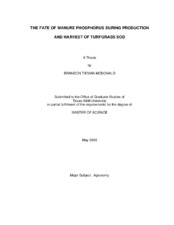| dc.description.abstract | Removal of manure from dairies to sites less prone to point-source nutrient
pollution is an option for dealing with dairy confined animal feeding operation
wastes. Applications of dairy manure waste to turfgrass sod can be an
environmentally sound approach because both plant matter and soil are
removed during harvest (Vietor et al., 2002).
Field scale research was conducted on a pair of adjacent, 1.42 ha Tifway
bermudagrass fields on a fine-textured clay soil to investigate the fate of manure
phosphorus (P) from composted dairy manure applications. Both fields received
equal rates of supplemental nitrogen fertilizer but one was treated with
composted dairy manure. The treated field received 75 kg ha-1 P during the first
crop. After harvest, 127 kg ha-1 P was applied to the second crop. Once reestablished,
this crop was harvested.
Surface layer sod and subsurface soil were frequently sampled on a grid
pattern from each field and analyzed to monitor soil P. Both plant extractable
and total P analyses were used. It was determined that a sod harvest couldeffectively remove all of the applied manure P. Below the sod layer, there were
no increases in soil P as a result of the composted dairy manure treatments,
indicating that P leaching did not occur.
Phosphorus runoff during rain events or irrigation was monitored by
members of the Department of Biological and Agricultural Engineering. It was
reported that more P was lost in runoff from the compost treated field than the
untreated field.
Cumulative water infiltration rate, soil bulk density, and plant available
water holding capacity of the soil were tested to determine if the composted
dairy manure treatments affected these soil physical properties. The only
significant change was an increase in plant available water holding capacity on
the surface layer of the treated field.
An economic analysis was performed using actual financial data from the
project. A scenario was created to investigate the feasibility of a dairy farm
profitably adding a small turfgrass sod enterprise to its operation. It was
determined that a sod field enterprise could be moderately to highly profitable for
a dairy. | en |


